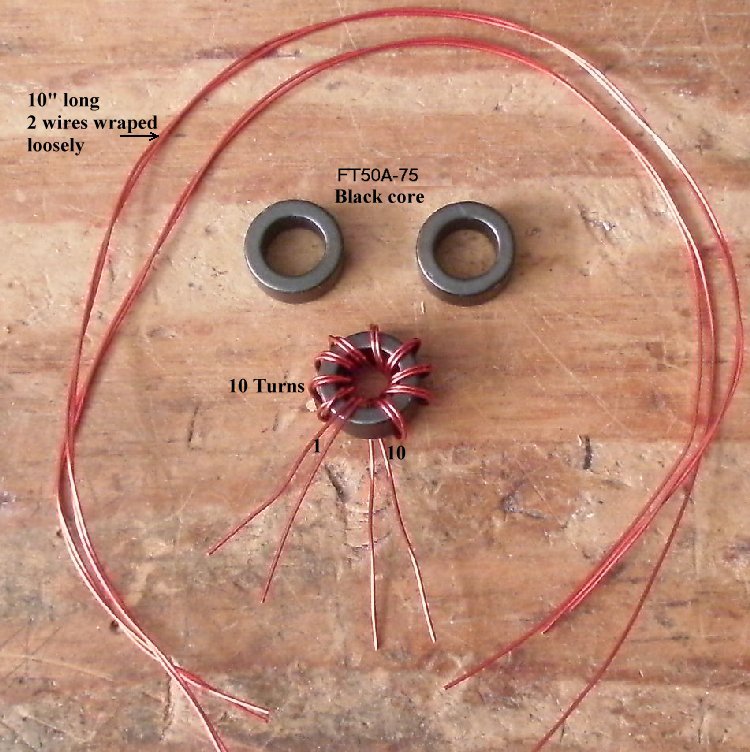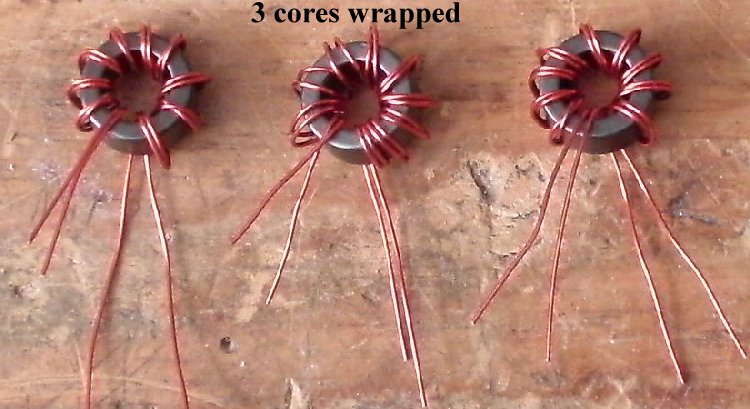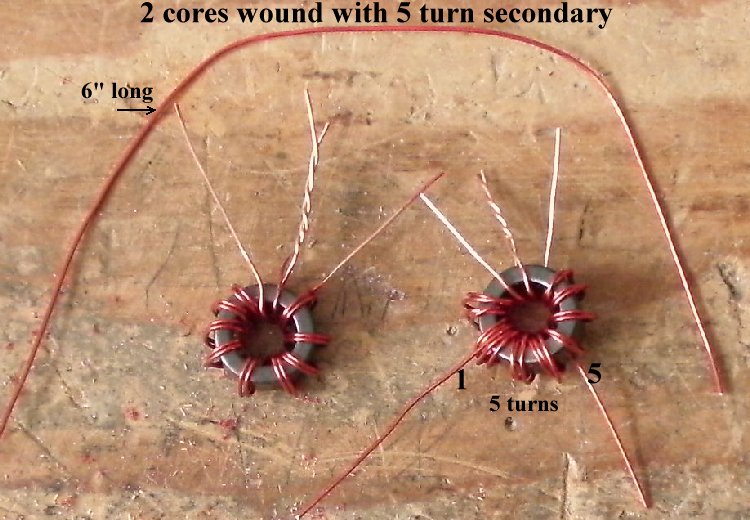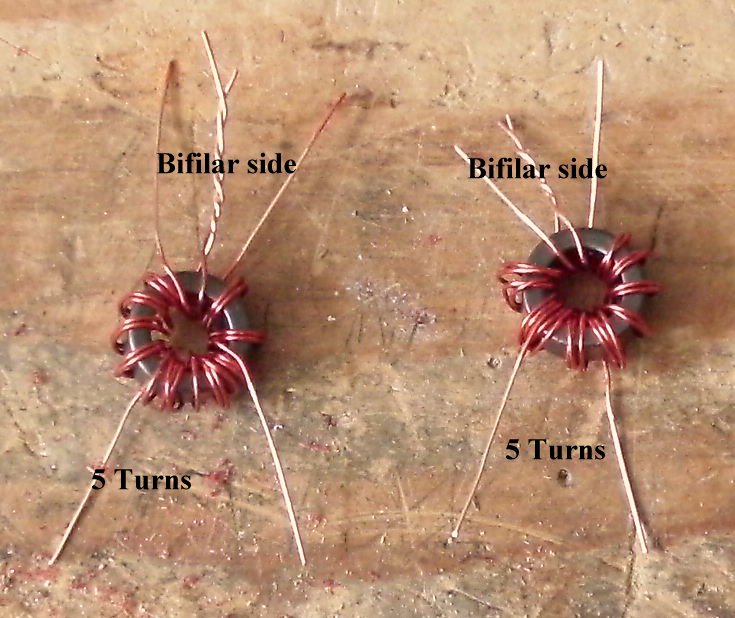


To learn about the First Mixer, read the
Circuit Details - First Mixer & Amplifier.
To learn about the Crystal Filter, read the
Circuit Details - Crystal Filter.


 ____20 - .01 capacitors (Bag 3) Probably best to do one vertical column of .01'a at a time, i.e. 3, 5, 4, 5, and 3 capacitors. |


|
____6 - 100 ohm resistors (brown, black, brown) (Bag 3) |


|
____7 - 100K resistors (brown, black, yellow) (Bag 3) |


|
____1 - 470 ohm (Bag 4), One is located at the top left of the first mixer, and the other two are located to the top and right of the IR LEDs. |


|
____4 - MOSFETs (Bag 2), (Picture) static sensitive part, touch a ground wire before taking it out of the bag, notice the dot on MOSFET (may be difficult to see, hold at an angle to a light source and you can see the shadow of the dot), the dot is located to the left of the second line of the text on the MOSFET. A dot is placed outside the footprint so that you can double check your placement after it has been soldered to the PCB. The leads on each side of the part need to spread apart slightly to fit the footprint. |


|
____3 - LEDs (Bag 3), Red colored, match the flat on the LED to the flat on the footprint. The short lead is on the same side as the flat. Note: If you ordered the Bright Red LEDs, they can replace the ones in the mixer. See Modifying the LEDs. ____1 - IRED (Bag 4), Smoky colored, on a cardboard strip, do not cut the leads off the strip, tear the IREDs off the strip and clean the bottom of the leads. The short lead is on the same side as the flat. Mount as high as possible and match the flat on the IRED to the flat on the footprint. Bend the IRED toward the Phototransistor at the MOSFET VFO amplifier. Aim the phototransistor back toward the IRED. A piece of black tubing will be placed between the two devices to direct the IR light. |


Winding and Installing the FT50A(wide)-75 Transformers____3 - FT50A-75 ferrites (Bag 4) and enameled wire (Bag 6) |




|
Scrape the lead wires of their enamel coating. Use a VOM and arrange the wires as shown in the picture below putting the ones having continuity (zero ohms) on the same side. Wrap one wire from the top to the opposite side bottom wire. |


Two of the Bifilar windings need a 5 turn Secondary |




Bend the leads as shown below for easy insertion into the PCB |


Install as shown below   Please Check!Carefully inspect the wires on the bifilar side of the cores and make sure they are not shorted. There is no ohm meter check for this error, so you must look carefully. Make sure the bare parts of the wires are not touching! Double check underneath the board to make sure there is not a solder bridge between the leads. The second and third core (counting from the front) carry 12 Volts. If the bifilar leads are shorted there will be some burning (smoke) of the wires, the LEDs will not light up, and the 100 ohm resistor that feeds 12 Volts to that core will need to be replaced if it is black or shows open with a VOM. You can check the voltage at the 'D' pin of the 2 MOSFETs (both the SB Mixer and SB Amplifier) for 11 to 12 volts. If one 'D' pin shows 6 volts and the other about 11 Volts, then one lead of the bifilar core is unsoldered. If neither MOSFET has about 11 volts, check the center lead of the bifilar core.  ____2 - Connection Loops - The wire loops for the 'VFO IN' box and 'Ground' are installed underneath the board. The coax cable from the First Mixer 'VFO IN/Ground' box goes to the VFO Amplfier 'VFO OUT/Ground' box. This cable will be installed after the board is populated. See Making Loops for Connections on the Boards for making easy connections to the board for testing and completing the board. Click 'Back' on your browser to return here.  |


|
____5 - .01 capacitors (Bag 3) The IRED near the outside of the board may be used depending on the setup of the ceystal filters. |


|
____2 - 100 ohm resistors (brown, black, brown) (Bag 3) |


|
____2 - RF Chokes (Bag 3), Footprint on PCB is rectangle with square edges, "RF" inside the rectangle. Choke is about the size of a 1 watt resistor with rounded edges. |


|
____3 - 3.457MHz crystal (Bag 4), Has a gray plastic cover over the crystal with the markings "NYMPH C O 17915-03". Note: 99% of all the crystals we have tested have been within 100Hz of each other (both values), so no matching is necessary. |

|
The picture below shows the fully loaded crystal filter with 3.547 MHz crystals/capacitors mounted in machine pins. The top filter uses 100pf capacitors (use 39pf for even wider bandwidth) for wide bandwith and the lower crystal filter uses 390pf poly capacitors (anything above 200pf will work) for narrow bandwidth. The poly caps have thin leads which fit into the machine pins. Large value mica caps have thicker leads. |


|
____2 - Connection Loops
See Making Loops for Connections on the Boards for making easy connections to the board for testing and completing the board. Click 'Back' on your browser to return here. |


Modifications for a Single IF Frequency |

|
Saturate the ground braid with solder first, then solder the braid to the Ground Loops. Solder the center wire to the output(VFO OUT) and input(VFO IN) Wire Loops. |

Making and soldering the 'XTAL FILTER OUT' coax cable____Miniature Coax Cable, cut a 10" piece (Bag 6). Strip and prepare as explained above. ____Solder the center wire to "XTAL FILTER OUT", solder the braid to the "Ground" box. Leave the other end loose at this time. |


|
____Place the PCB in front of a bright light. If you see light shining through any of the soldering holes, you missed a solder connection. |
Send E-Mail || Amateur Radio Receivers || Back to Instructions for the SuperLuminescent Receiver

